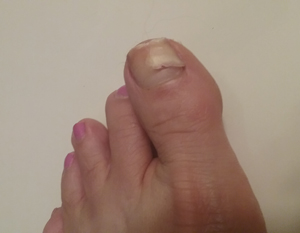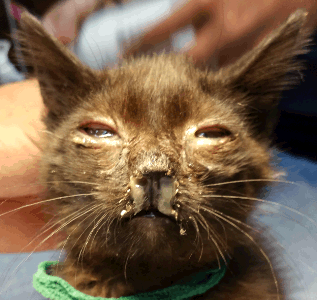cracked human toe

This photo is the one that squicked out Dr. Corp-Minamji scream. This crack happened when a human, a dog, and a cat all tried to get onto the porch at the same time, causing the human to step on top of a 4.5" tall door stop instead of over it. Photo by Phyllis DeGioia.
Everyone has a threshold for ick. For some the bar is so low a banana slug couldn’t slither under – a drop of blood, a slip of slime, and they’re on the floor out cold.
On the other hand, some can wade chest deep in awful offal, and go eat a sandwich after. AND we will happily recount our stories over dinner.
I’m one of the latter.
Pus? Love it.
Blood? Been in situations that would make Dracula queasy.
Gaping wounds? Fun jigsaw puzzles.
I’ve been up to my earlobes in rotting fetuses and removed cancerous eyeballs the size of grapefruit.
I’m also the mother who stands outside the bathroom feebly calling “Are you okay in there” to my vomiting child. Nor can I handle things in the arthropod or insect families.
Lice make me itch. Ticks make me squirm. Maggots make me gag.
My colleague, Dr. Tony Johnson, decided to share these lovely maggot stories (GAG GAG GAG):
“When I was a resident (and after we'd already dealt with the patient's needs) we used to have maggot races. We'd draw a little circle on the floor, write numbers on the maggots (you had to use the big ones) and whoever's maggot creepy-crawled out of the circle first won. I can't recall the prize for winning - maybe getting to lance the next giant cat abscess?”
“I had to deal with a cow dystocia (difficult birth) as a senior student. The cow was down and had had a dead calf stuck part way out in the hot summer sun. The face was alive with maggots, and we had to do a fetotomy and remove the dead calf - since the cow was down, we had to do most of it lying down, our faces in the puddled muck. After all was said and done, I was drenched in blood, pus and assorted other fluids. When I went to change and shower, I found I had a maggot in my ear.”
NO. Just no. Don’t get me wrong. I love a good dystocia, and cows are right up my alley.
Doing surgery on a cow makes me hungry. The very notion of putting a scalpel to human flesh makes me queasy. I’m the last person you want at a sickbed. I don’t want to see human scars or lesions.
On the other hand, I’ve watched a seasoned cop, who’d seen car wrecks and gory murders, nearly faint at the sight of a small, pink loop of bowel protruding from the body wall of his pet sheep.
Our VetzInsight and Veterinary Partner editor, Phyllis DeGioia, is notoriously squeamish. Given her career in veterinary writing, this occasionally lends us to a fair bit of teasing. So turnabout was fair play a couple of weeks ago when she started to tell me about a cracked toenail. I shut her down immediately, much to her manic delight. She couldn’t believe that the large animal vet with the cast iron stomach was squicked out by a toenail. She was entirely too happy to provide the photo for this post.
From quick discussion, it appears few of our VetzInsight writers are immune.
Dr. Teri Oursler is one of those who still gets queasy if she is not the one performing a procedure. She recounts her first day of veterinary school, “I ran out of the lecture hall when they put up a slide (6' tall) showing a poodle with a shoulder to paw degloving injury! The first time I watched a dog neuter (about as bloodless a procedure as you can get!), the vet noticed me swaying and sent me outside. This was when I was shadowing a vet to decide if I could go to vet school, knowing that the sight of blood kills me. And it appears, I went anyway!”
Teri once decided she needed to give blood at the local blood draw, after all, it was a good, caring thing to do! So, off she went, even though seeing blood makes her ill. She got in line, and her ears started buzzing. She filled out the paperwork and she started seeing black spots. She waited in line for them to take her blood, getting more and more nauseous. Finally, it was her turn and they would not even take her blood as she was on medications for ulcers. She had to go home for a 3 hour nap to recover from filling out the paperwork! She has decided that there are other things she can do to be a help to society, but giving blood is not in her cards.
I used to make my husband clean up the cat and dog vomit. The conversations would go like this:
“Jasmine puked in the kitchen!” I would call, running from the smell as quickly as possible.
“Aren’t YOU the veterinarian?”
“Horses can’t vomit!”
Dr. Mark Rishniw, a veterinary cardiologist, has done much the same thing to his ever-suffering (his term, not mine) wife:
Spouse "Dog just crapped all over the sun porch. You need to clean it up."
Mark: "Why? Why can't you do it?"
Spouse: "Because you're a vet."
Mark: "Cardiologists don't deal in poop. Call a gastroenterologist.”
cat URI

This poor pet with an upper respiratory infection has the kind of cat snot that makes Dr. Wendy Wilson scream. Photo by Dr. Wendy Brooks.
One of the best students ever to ride with me spent his first day volunteering at our practice by passing out while assisting a doctor with dehorning a goat. He fell backwards, flat to the ground, pulling the rather large goat off the table on top of him.
After that, he remembered to eat lunch and not lock his knees while procedures were going on. He graduated veterinary school, and I’m pretty sure he became a fabulous veterinarian.
Dr. Wendy Wilson gets weirded out by cat snot and dog drool of all things. She says, “I cannot tolerate those giant ropes of spit hanging out of happy dogs that are flinging that nastiness all over the place.” Teri agreed, saying those two things make her “stomach clench.”
On the other hand, when their horse tore open his shoulder, Wendy was completely calm while her husband “was doing a mighty fine icky-icky dance and thought we’d have to put him [the horse, not the husband] down.”
Dr. Carla Burris calls herself the “poster child for the difference between animal-ick and human ick.” She says, “The dog or cat is retching on the bed? I've been known to catch (most of) it in my hands when there's no time to get them to the floor. I'm not a sympathetic puker -- the worst wet or strenuous retching sounds may induce a vague stomach twinge -- but just the thought of cleaning up human vomit makes my salivary glands spasm.”
Carla doesn’t cope well with needles when they are pointed in her direction. “If I became an insulin-dependent diabetic and had to stick myself...best to just start picking out the coffin cuz it ain't gonna happen. On the rare occasions when I donate blood, I've learned to warn the staff that I will turn extremely white, maybe even a bit vagal, when they stick me but they should just keep going as I'll recover as the bag fills and be fine to leave right after. I do make sure I'm positioned so that I'll stay in place should there be a sudden lack of consciousness. (I'm super considerate that way...)”
Everyone has a threshold for ick. If your animal has a condition that requires your care to manage at home, and you’re feeling woozy at the thought of changing a bandage, flushing an abscess, or cleaning up random goo, don’t be embarrassed. If nothing else, this post should tell you you’re not alone.
Talk to your veterinarian. It’s better for them to know what sort of home care will be difficult for you. If you’re up front with your personal “ick factors,” your veterinarian and technicians can help come up with a plan for your pet that won’t leave you gagging, reeling, or needing medical care of your own.
1 Comment
Hubert Hiemstra
October 29, 2017